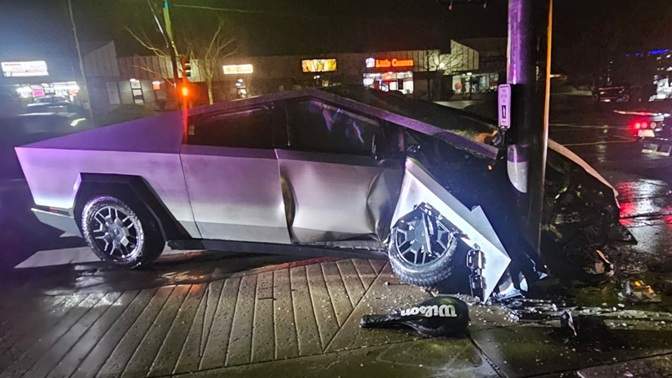Tesla’s Full Self-Driving (FSD) technology is often at the center of heated discussions. While CEO Elon Musk has been vocal about achieving truly autonomous driving, a recent Tesla Cybertruck crash involving FSD raises serious concerns about its reliability and the risks of overconfidence in the system.

A Tesla Cybertruck owner, Jonathan Challinger, recently shared his harrowing experience on social media after his vehicle crashed into a pole while using FSD. His story quickly gained traction, sparking debates over Tesla’s promises and the realities of self-driving technology.
Challinger, a software developer from Florida, explained that he was using Tesla’s latest FSD version (v13.2.4) while driving in the right lane. As the lane ended and merged left, the system failed to react appropriately. Instead of smoothly transitioning, the Cybertruck hit the curb and then collided with a light post. Fortunately, Challinger escaped unharmed, but the incident serves as a critical lesson in the limitations of self-driving technology.
The crash highlights a significant issue with Tesla’s FSD: its failure to recognize and respond to lane endings effectively. Despite Tesla’s claims of advanced lane detection and navigation capabilities, the system did not attempt to change lanes or slow down, leading to the accident.
Challinger admitted that he didn’t react in time to take control of the vehicle, emphasizing the risk of driver complacency. He posted about the incident as a “public service announcement,” urging other Tesla owners to stay vigilant while using FSD.
The Illusion of Autonomy
Tesla markets FSD as an advanced driver assistance system, yet many drivers treat it as near-autonomous technology. Elon Musk has repeatedly claimed that Tesla is on the verge of achieving unsupervised self-driving, leading some owners to develop a false sense of security. However, the reality is that Tesla’s self-driving capabilities still require constant driver supervision.
Despite Musk’s promises, Tesla’s technology has faced numerous setbacks. FSD has been in development for years, with Musk claiming each new update brings the company closer to true autonomy. Yet, crashes like Challinger’s prove that the system still has fundamental flaws that make it unreliable for fully autonomous driving.
One of the biggest dangers of Tesla’s FSD is driver complacency. When the system functions correctly most of the time, it’s easy to trust it blindly. However, as Challinger’s crash demonstrates, even a single failure can have serious consequences. He acknowledged his mistake, warning fellow Tesla owners not to become too comfortable with the system:
“Big fail on my part, obviously. Don’t make the same mistake I did. Pay attention. It can happen.”
This statement highlights a crucial issue: FSD is not perfect, and drivers must remain engaged at all times. Unlike traditional cruise control, FSD requires active supervision because it can still make critical errors.
Elon Musk’s Controversial Claims
Musk’s ambitious claims about Tesla’s self-driving capabilities have created unrealistic expectations. He has frequently stated that FSD will soon operate without human intervention, yet incidents like this crash tell a different story.
Tesla influencers often post videos showcasing FSD successfully navigating complex roads, reinforcing the idea that autonomy is just around the corner. However, these videos do not account for the countless scenarios where FSD fails to respond correctly. The system still struggles with unpredictable road conditions, sudden lane endings, and real-time decision-making.
Tesla’s quarterly safety reports also paint an overly optimistic picture, suggesting that FSD is safer than human driving. However, critics argue that these reports lack transparency and fail to account for the system’s real-world limitations. If Tesla were developing FSD without exaggerated claims, it might be seen as a revolutionary product. Instead, the hype around it has led to increasing skepticism and, in some cases, dangerous assumptions by drivers.
Many Tesla owners have reported similar issues with FSD failing to detect lane endings. The system often works well, but occasional lapses make it unreliable for full autonomy. A common experience among users is hesitating to intervene because they trust the system will correct itself. Unfortunately, as seen in Challinger’s case, waiting too long can lead to accidents.
While FSD is undoubtedly impressive technology, it is not infallible. Tesla owners must remain aware of its shortcomings and be prepared to take control at a moment’s notice.
Tesla continues to push forward with FSD development, but the timeline for true autonomy remains uncertain. The latest crash serves as a stark reminder that self-driving technology is still in its infancy. While advancements are being made, Tesla’s system is not yet capable of operating without human oversight.
For now, the best advice for Tesla owners is simple:
- Treat FSD as an assistance tool, not a replacement for attentive driving.
- Always be prepared to take control of the vehicle.
- Don’t buy into the hype—self-driving still has a long way to go.
The Cybertruck crash is a wake-up call for Tesla enthusiasts and self-driving advocates. While FSD offers incredible potential, it is far from perfect. Elon Musk’s grand vision of fully autonomous Teslas may one day become a reality, but for now, human vigilance is still required.
If you own a Tesla with FSD, take this incident as a learning opportunity. Stay alert, stay engaged, and don’t fall into the trap of overtrusting a system that still has flaws. The road to autonomy is long, and we are not there yet.
Related Post
